Rep:Mod:HYT01496067
NH3 Optimisation
| Information | |||||
|---|---|---|---|---|---|
| |||||
| More Info | |||||
| Calculation Method | RB3LYP | ||||
| Basis Set | 6-31G(d,p) | ||||
| Final Energy E(RB3LYP) | -56.55776873 a.u. | ||||
| RMS Gradient Norm | 0.00000486 a.u. | ||||
| Point Group | C3V | ||||
| N-H Bond Distance | 1.02 Å | ||||
| H-N-H Bond Angle | 106° | ||||
Item Value Threshold Converged? Maximum Force 0.000004 0.000450 YES RMS Force 0.000004 0.000300 YES Maximum Displacement 0.000072 0.001800 YES RMS Displacement 0.000035 0.001200 YES
Vibration Modes
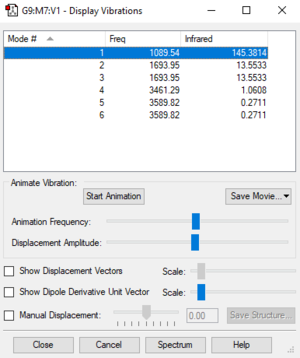
| Mode | 1 | 2 | 3 |
| Wavenumber cm-1 | 1090 | 1694 | 1694 |
| Symmetry | A1 | E | E |
| Intensity | 145 | 14 | 14 |
| Image | 
|
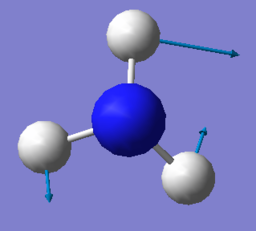
|
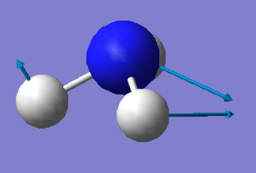
|
| Mode | 4 | 5 | 6 |
| Wavenumber cm-1 | 3461 | 3590 | 3590 |
| A1 | E | E | |
| Intensity | 1 | 0 | 0 |
| Image | 
|
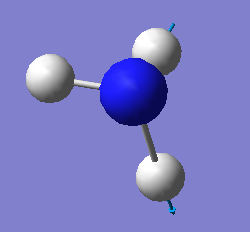
|
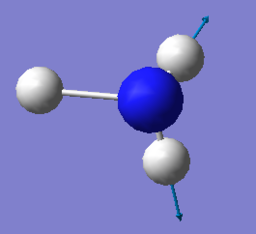
|
- From the 3N-6 rule, 3 modes are expected to be seen.
- 6 modes are seen in the vibration display, with mode 2 and mode 3 are degenerate and mode 5 and mode 6 are degenerate.
- Mode 1, 2 amd 3 are bending vibrations and mode 4, 5 and 6 are bending vibrations.
- Mode 1 and mode 4 are highly symmetric.
- Mode 1 is the "umbrella" mode.
- 3 bands are expected to be seen in an experimental spectrum gaseous ammonia, but since the last band has extremely low intensity, it might not be noticeable in the spectrum.
Atomic Charges

- Charge on N atom: -1.125e
- Charge on H atoms: 0.375e
H2 Optimisation
| Information | |||||
|---|---|---|---|---|---|
| |||||
| More Info | |||||
| Calculation Method | RB3LYP | ||||
| Basis Set | 6-31G(d,p) | ||||
| Final Energy E(RB3LYP) | -1.17853935 a.u. | ||||
| RMS Gradient Norm | 0.00003809 a.u. | ||||
| Point Group | DinfH | ||||
| H-H Bond Distance | 0.74 Å | ||||
| H-N-H Bond Angle | 180° | ||||
Item Value Threshold Converged?
Maximum Force 0.000066 0.000450 YES
RMS Force 0.000066 0.000300 YES
Maximum Displacement 0.000087 0.001800 YES
RMS Displacement 0.000123 0.001200 YES
N2 Optimisation
| Information | |||||
|---|---|---|---|---|---|
| |||||
| More Info | |||||
| Calculation Method | RB3LYP | ||||
| Basis Set | 6-31G(d,p) | ||||
| Final Energy E(RB3LYP) | -109.52412868 a.u. | ||||
| RMS Gradient Norm | 0.00000365 a.u. | ||||
| Point Group | DinfH | ||||
| N-N Bond Distance | 1.11 Å | ||||
| N-N Bond Angle | 180° | ||||
Item Value Threshold Converged?
Maximum Force 0.000006 0.000450 YES
RMS Force 0.000006 0.000300 YES
Maximum Displacement 0.000002 0.001800 YES
RMS Displacement 0.000003 0.001200 YES
Structure and Reactivity
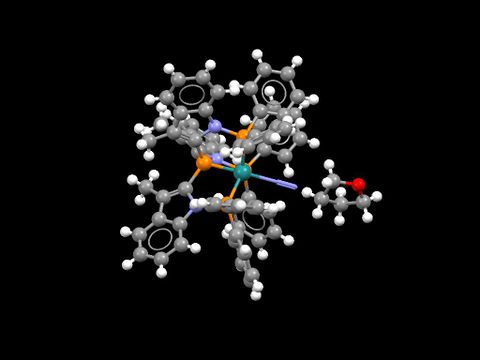
- Molecular formula: C63H51N5P4Ru, C4H8O
- Unique Identifier: [| DEKFUX]
- N-N bond length: 1.086(6)Å
- The N-N bond length is shorter than that recorded fot the N2 molecule, 1.11 Å.
- The crystal structure is shorter than the computational distances, since in the metal complex, the N2 molecule is attached to a transition metal, Ruthenium, and the molecule is solvated by tetrahydrofuran. The N2 molecule is partially negative since N has high electronegativity, therefore it repels the Oxygen atom in the solvate. In a crystalline (solid) structure, the space between molecules is compressed, hence the N-N bond length is shortened, while N2 is in gas state, hence N2 molecule has longer bond length.
- N2 has a literature of 1.0976 ± 0.0002 re, hence the computational value is not very accurate as well.
Reference:[| Tables of Interatomic Distances and Configuration in Molecules and Ions, L.E. Sutton, ed., London: The Chemical Society, 1958.], page 70.
Haber-Bosch Process
N2 + 3H2 -> 2NH3
Energy Calculation
- E(NH3)= -56.5577687 au
- 2*E(NH3)= 2*(-56.5577687)= -113.1155374 au
- E(N2)= -109.5241287 au
- E(H2)= -1.1785394 au
- 3*E(H2)= 3*(-1.1785394)= - 3.5356182
- ΔE=2*E(NH3)-[E(N2)+3*E(H2)]= (-113.1155374)-[(-109.5241287)+(- 3.5356182)]= -0.0557905 au
- ΔE= (-0.0557905)au * 2625.5 kJmol-1/au= -146.4779578 kJmol-1= -146.5 kJmol-1
Since ΔE is negative, the process is exothermic, hence the product is in lower energy state than the reactants. As a result, the ammonia product is more stable.
Chosen Molecule: SH2
| Information | |||||
|---|---|---|---|---|---|
| |||||
| More Info | |||||
| Calculation Method | RB3LYP | ||||
| Basis Set | 6-31G(d,p) | ||||
| Final Energy E(RB3LYP) | -399.39162414 a.u. | ||||
| RMS Gradient Norm | 0.00012068 a.u. | ||||
| Point Group | C2V | ||||
| S-H Bond Distance | 1.34737 Å | ||||
| H-S-H Bond Angle | 92.681 | ||||
Item Value Threshold Converged?
Maximum Force 0.000175 0.000450 YES
RMS Force 0.000145 0.000300 YES
Maximum Displacement 0.000472 0.001800 YES
RMS Displacement 0.000386 0.001200 YES
Vibration Modes

| Mode | 1 | 2 | 3 |
| Wavenumber cm-1 | 1224 | 2692 | 2712 |
| Symmetry | A1 | A1 | B2 |
| Intensity | 5 | 7 | 9 |
| Image | 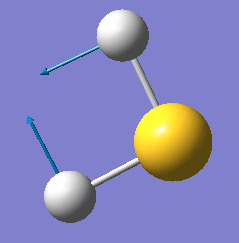
|
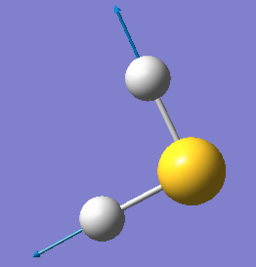
|
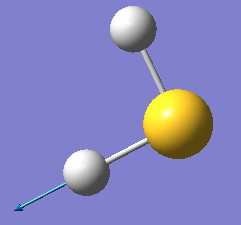
|
Atomic Charges
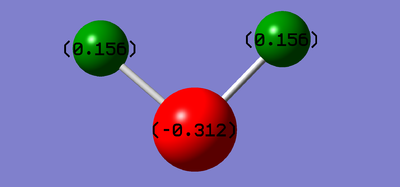
- Charge on S atom: -0.312e
- Charge on H atoms: 0.156e
Energy Calculation
S + H2 -> SH2
- E(SH2)= -399.3916241 au
- E(S)= -398.0425733 au (result obtained from optimising a single S atom)
- E(H2)= -1.1785394 au
- ΔE=E(SH2)-[E(S)+E(H2)]= (-399.3916241)-[(-398.0425733)+(-1.1785394)]= -0.1705114 au
- ΔE= (0.1705114)au * 2625.5 kJmol-1/au= -447.6776807 kJmol-1= -477.7 kJmol-1
Molecular Orbitals
| Summary of MOs | No. of MOs | Image of MOs |
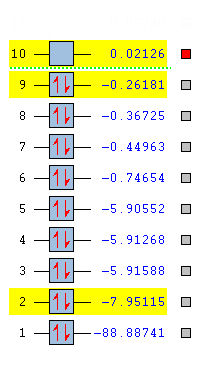
|
10 | 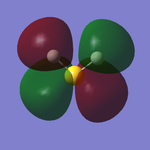
|
| 9 | 
| |
| 8 | 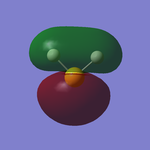
| |
| 7 | 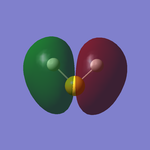
| |
| 6 | 
| |
| 5 | 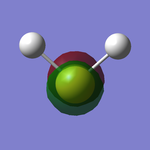
| |
| 4 | 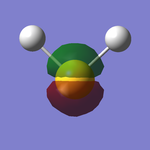
| |
| 3 | 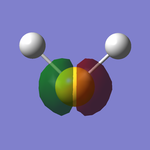
| |
| 2 | 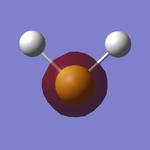
| |
| 1 | 
|
- The highest occupied molecular orbital (HOMO) in this molecule is MO no. 9, and the lowest unoccupied molecular orbital (LUMO) in this molecule is 10
- From MO=6 and onwards, the ovelap occurs between the valence AOs of the atoms, hence the overlap is more significant.
- Valence AOs from S atom: 3s, 3px, 3py, 3pz
- Two 1s orbitals from the two H atoms overlap in-phase and out-of-phase respectively, creating two Ligand Group Orbitals.
- 3s orbital in S overlap in phase with the in-phase LGO to from MO=6, a bonding orbital.
- MO=7 is contributed by the 3py orbital from S atom and the out-of-phase LGO orbital from the two H atoms overlapping constructively.
- MO=8 is contributed by 3s and 3pz from the S atom and the in-phase LGO overlapping constructively.
- For MO=9, the orbital is simply a non-bonding 3px orbital from the S atom. This is the HOMO of the SH2 molecule.
- For MO=10, it is resulted from the 3py orbital in S overlapping with the out-of-phase LGO destructively, forming an anti-bonding orbital. This is the LUMO of the SH2 molecule.
Marking
Note: All grades and comments are provisional and subject to change until your grades are officially returned via blackboard. Please do not contact anyone about anything to do with the marking of this lab until you have recieved your grade from blackboard.
Wiki structure and presentation 1/1
Is your wiki page clear and easy to follow, with consistent formatting?
YES
Do you effectively use tables, figures and subheadings to communicate your work?
YES - good use of tables.
NH3 0/1
Have you completed the calculation and given a link to the file?
No link to the log file.
Have you included summary and item tables in your wiki?
YES
Have you included a 3d jmol file or an image of the finished structure?
YES
Have you included the bond lengths and angles asked for?
YES
Have you included the “display vibrations” table?
YES
Have you added a table to your wiki listing the wavenumber and intensity of each vibration?
YES
Did you do the optional extra of adding images of the vibrations?
YES
Have you included answers to the questions about vibrations and charges in the lab script?
Good answers to the vibrations questions - there are two peaks visible as vibrations 4, 5, and 6 have too low an intensity to be seen. You didn't explain why the charges on the atoms are there - nitrogen is more electronegative than hydrogen.
N2 and H2 0/0.5
Have you completed the calculations and included all relevant information? (summary, item table, structural information, jmol image, vibrations and charges)
YES
However you have given a bond angle of 180 for N2 and H2, there are no bond angles in diatomic molecules. Bond angles involve exactly 3 atoms.
Crystal structure comparison 0.5/0.5
Have you included a link to a structure from the CCDC that includes a coordinated N2 or H2 molecule?
YES
Have you compared your optimised bond distance to the crystal structure bond distance?
YES
Haber-Bosch reaction energy calculation 1/1
Have you correctly calculated the energies asked for? ΔE=2*E(NH3)-[E(N2)+3*E(H2)]
YES
Have you reported your answers to the correct number of decimal places?
YES
Do your energies have the correct +/- sign?
YES
Have you answered the question, Identify which is more stable the gaseous reactants or the ammonia product?
YES
Your choice of small molecule 2.5/5
Have you completed the calculation and included all relevant information?
YES but you forgot to link to the log file again.
Have you added information about MOs and charges on atoms?
YES - the explanation of how the different AOs contribute to each MO was very good. You could have explained the charges in terms of electronegativity. You explained the bonding vs antibonding characters of the MOs well but not how the contribute to the bonds between atoms. For example the LUMO has an antibonding character but it doesn't contribute to the bonding in the molecule as it is unoccupied.
Independence 1/1
If you have finished everything else and have spare time in the lab you could: Check one of your results against the literature, or Do an extra calculation on another small molecule, or Do some deeper analysis on your results so far
you did an extra energy calculation and an extra calculation on S well done!
